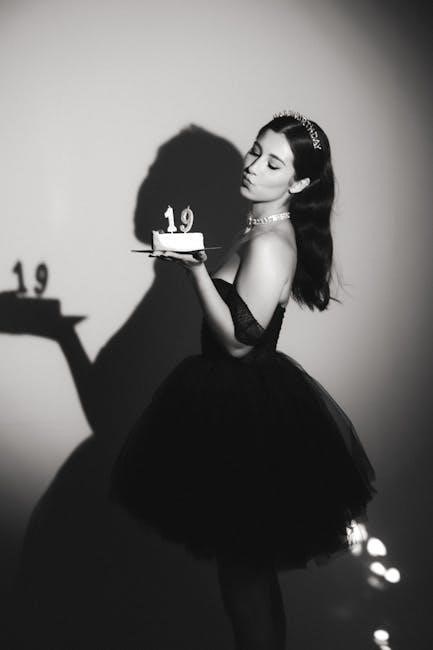The 1968 American heist film, directed by Norman Jewison, follows Thomas Crown, a wealthy businessman, and his intricate heist. The screenplay, written by Alan Trustman, is renowned for its tight narrative and memorable characters. Starring Steve McQueen and Faye Dunaway, the film explores themes of risk, power dynamics, and the allure of the antihero. The script, available as a PDF, showcases a masterclass in storytelling, blending suspense with romantic tension, making it a timeless classic in cinema history.
1.1 Overview of the Film
The Thomas Crown Affair (1968) is a stylish American heist film directed by Norman Jewison, starring Steve McQueen as the suave millionaire Thomas Crown and Faye Dunaway as Vicki Anderson, the determined insurance investigator. The movie follows Crown’s elaborate bank heist and his cat-and-mouse game with Anderson, blending suspense with a magnetic romantic tension. Known for its iconic locations, memorable dialogue, and McQueen’s charismatic performance, the film became a classic, balancing sophistication with gritty crime elements, leaving a lasting impression on the heist genre.

1.2 Historical Context of the 1968 Release
The Thomas Crown Affair (1968) was released during a transformative period in American cinema and culture. The late 1960s marked a shift toward more daring storytelling and complex characters, reflecting societal changes. Directed by Norman Jewison, the film captured the essence of the era with its sleek style and thematic depth. Its release coincided with growing interest in heist narratives and antiheroes, resonating with audiences seeking fresh, sophisticated entertainment. The film’s success was also fueled by its charismatic leads, Steve McQueen and Faye Dunaway, who embodied the glamour and intrigue of the times.
1.3 Importance of the Script in Film History
Alan Trustman’s screenplay for The Thomas Crown Affair (1968) is celebrated for its innovative structure and sharp dialogue. It introduced a new wave of heist films, blending suspense with romantic tension. The script’s exploration of power dynamics and the antihero archetype set a benchmark for future crime dramas. Its influence is evident in modern cinema, making it a landmark in screenwriting. Available as a PDF, the script remains a study piece for filmmakers and writers, highlighting its enduring relevance in film history.

Production Background
Directed by Norman Jewison, The Thomas Crown Affair (1968) stars Steve McQueen and Faye Dunaway, with Haskell Wexler’s cinematography and Alan Trustman’s script, available as a PDF.
2.1 Director Norman Jewison’s Vision
Norman Jewison’s direction in The Thomas Crown Affair (1968) masterfully blended style, suspense, and romance, creating a sophisticated heist film. His vision emphasized tight pacing and visual elegance, capturing the film’s unique atmosphere. Collaborating with cinematographer Haskell Wexler, Jewison crafted iconic scenes, such as the opening heist, which showcased his meticulous attention to detail. The chemistry between Steve McQueen and Faye Dunaway was elevated by Jewison’s nuanced handling of their characters’ complex relationship. His work laid the groundwork for the film’s enduring appeal and influence on the genre.
2.2 Screenwriter Alan Trustman’s Contribution
Alan Trustman’s screenplay for The Thomas Crown Affair (1968) is celebrated for its originality and sophistication. His script masterfully intertwines a daring heist with a complex romantic dynamic, creating a narrative that captivates audiences. Trustman’s dialogue is sharp and memorable, particularly in the exchanges between Crown and Anderson, which highlight their power struggle and chemistry. The PDF version of the script showcases his meticulous craftsmanship, offering insights into his storytelling approach. Trustman’s work not only defined the film’s tone but also set a benchmark for heist movies, ensuring its enduring influence in cinema history.
2.3 Key Producers and Their Roles
Norman Jewison not only directed but also produced The Thomas Crown Affair, ensuring the film’s vision aligned with its sophisticated script. Hal Ashby, as associate producer, played a pivotal role in managing production logistics and maintaining creative consistency. Their collaboration with Alan Trustman and Haskell Wexler brought the story to life, blending cinematic excellence with a gripping narrative. The producers’ attention to detail and commitment to quality helped establish the film as a landmark in heist cinema, leaving a lasting impact on the genre.

Cast and Characters
Steve McQueen stars as Thomas Crown, a charismatic millionaire, while Faye Dunaway plays Vicki Anderson, an alluring insurance investigator. Their on-screen chemistry captivates audiences, driving the story.
3.1 Steve McQueen as Thomas Crown
Steve McQueen embodies Thomas Crown, a suave and calculating millionaire, with effortless charm. His portrayal brings depth to Crown’s risk-taking nature and magnetic presence. The script highlights his character’s complexity, blending sophistication with rebellion. McQueen’s performance became iconic, defining the role and cementing his status as a Hollywood legend. His chemistry with co-star Faye Dunaway adds layers to the story, making Crown a memorable antihero in cinema history. His role is central to the film’s success and enduring appeal.
3.2 Faye Dunaway as Vicki Anderson
Faye Dunaway stars as Vicki Anderson, a determined and alluring insurance investigator tasked with solving the heist. Her performance brings sophistication and intensity to the role, creating a dynamic tension with Steve McQueen’s Thomas Crown. The script highlights her character’s intelligence and independence, making her a formidable opponent in both the heist and the romantic game. Dunaway’s portrayal earned widespread acclaim, solidifying her role as an iconic figure in the film. Her chemistry with McQueen is undeniable, adding depth to the story’s intricate plot and emotional layers.
3.3 Supporting Cast and Their Impact
The supporting cast of The Thomas Crown Affair adds depth and complexity to the story. Yaphet Kotto and Denzel Washington deliver standout performances, bringing nuance to their characters. Their roles not only enhance the plot but also amplify the tension and dynamics between the leads. The chemistry among the cast members is evident, making their interactions memorable. The supporting actors’ portrayals of their characters’ motivations and emotions contribute significantly to the film’s engaging narrative and its enduring appeal. Their performances are integral to the film’s success and legacy.

Plot Structure and Script Highlights
The script masterfully intertwines a complex heist with a simmering romance. Crown’s meticulous planning contrasts with the unpredictable chemistry between him and Vicki, creating tension and intrigue throughout.
4.1 The Heist as a Central Plot Device
The heist in The Thomas Crown Affair serves as both a literal and metaphorical centerpiece, driving the plot’s tension and character development. Thomas Crown’s meticulously planned robbery showcases his calculated risk-taking and charm, while Vicki Anderson’s investigation adds layers of suspense. The script cleverly interweaves the heist’s intricacies with the evolving dynamic between Crown and Anderson, creating a dual narrative of crime and romance. This structure not only highlights Crown’s audacity but also explores themes of control and attraction, making the heist a pivotal element in the story’s progression.
4.2 The Romantic Dynamic Between Crown and Anderson
The romance between Thomas Crown and Vicki Anderson is a magnetic interplay of power and allure. Their relationship evolves from adversarial curiosity to mutual fascination, blending professional rivalry with personal attraction. The script masterfully balances their intellectual sparring with understated emotional depth, creating a connection that transcends the heist. Steve McQueen and Faye Dunaway’s chemistry is undeniable, bringing complexity to their characters’ motivations. Their dynamic becomes a central emotional anchor, complementing the suspense of the heist and enriching the film’s narrative with layers of passion and vulnerability.
4.3 Key Dialogue Exchanges
The script’s dialogue crackles with tension and chemistry, particularly in exchanges between Crown and Anderson. Their conversations are laced with wit, challenge, and subtle attraction. A memorable moment occurs when Anderson confronts Crown about the heist, blending professional intensity with personal intrigue. Their dialogue reveals their intellectual match and mutual fascination, adding depth to their relationship. These exchanges, delivered by Steve McQueen and Faye Dunaway, are sharp and evocative, encapsulating the film’s blend of suspense, romance, and character complexity.

Themes Explored in the Script
The script delves into the psychology of risk and reward, the power dynamics between Crown and Anderson, and the allure of the antihero, exploring themes of control, desire, and moral ambiguity.
5.1 The psychology of Risk and Reward
The script explores Thomas Crown’s obsession with high-stakes heists, driven by the thrill of risk rather than financial gain. His actions reveal a deeper psychological need for control and excitement, even as he navigates the consequences. The dynamic with Vicki Anderson introduces a personal reward, complicating his motivations. This interplay of danger and desire underscores the film’s tension, making Crown a compelling antihero who embodies the allure of living on the edge, where the risk itself becomes the ultimate prize.
5.2 Power Dynamics in Relationships
The script delves into the intricate power dynamics between Thomas Crown and Vicki Anderson, where control and surrender are constantly negotiated. Their relationship is a cerebral and sensual game of cat and mouse, with each trying to outmaneuver the other. Crown’s dominance is challenged by Vicki’s independence, reflecting the societal shifts of the late 1960s. The chess metaphor underscores their intellectual sparring, while their mutual attraction blurs the lines between predator and prey, creating a complex interplay of power and vulnerability.
5.3 The Allure of the Antihero
Thomas Crown embodies the allure of the antihero, captivating audiences with his charisma and self-assuredness. His bold heist and carefree attitude defy societal norms, making him a compelling figure. Crown’s confidence and independence create a magnetic presence, drawing viewers into his world of risk and excitement. The script portrays him as a flawed yet intriguing character, whose audacity and charm make him both relatable and admirable. His antiheroic traits resonate with audiences, reflecting a fascination with characters who operate outside conventional boundaries, adding depth to the film’s narrative and timeless appeal.

Cinematic Elements
The film features Haskell Wexler’s striking cinematography, capturing iconic locations that enhance the story’s visual appeal. The soundtrack complements the tense atmosphere, blending seamlessly with the narrative’s pacing.
6.1 Haskell Wexler’s Cinematography
Haskell Wexler’s cinematography in The Thomas Crown Affair is a masterclass in visual storytelling. His use of lighting and composition creates striking visuals, enhancing the film’s sophisticated tone. Wexler’s work captures the elegance of the era, blending seamlessly with the story’s themes of risk and romance. His innovative techniques, such as dynamic camera movements and meticulous framing, elevate the narrative, making the film a visual triumph. Wexler’s cinematographic brilliance is a key element in the film’s enduring appeal and artistic legacy.
6.2 The Use of Iconic Locations
The Thomas Crown Affair showcasing iconic locations like Boston’s financial district and a luxurious beach house, adds sophistication to its narrative. These settings enhance the film’s themes of wealth and power. The contrast between urban professionalism and natural elegance underscores the characters’ lifestyles. The use of real-world locations, rather than studio sets, lends authenticity to the story, making the heist and romance more immersive. These iconic locales become characters in themselves, enriching the film’s visual appeal and enduring legacy. The locations perfectly complement the script’s tone and style.
6.3 The Soundtrack and Its Role
The soundtrack of The Thomas Crown Affair (1968) is a masterful blend of jazz and orchestral elements, perfectly complementing the film’s sophisticated tone. The iconic theme, “The Windmills of Your Mind,” composed by Michel Legrand, won an Academy Award and became synonymous with the film’s elegance. The music enhances the tension during the heist sequences and underscores the romantic chemistry between Crown and Anderson. Its innovative use of harmonies and rhythms mirrors the film’s modernist approach, making the soundtrack a timeless auditory experience.

Script Availability and PDF Versions
The official The Thomas Crown Affair (1968) script is available as a PDF online. It includes the final revised version by Alan Trustman. Legal and ethical considerations apply.
7.1 Where to Find the Official Script
The official script of The Thomas Crown Affair (1968) can be found on various online platforms. Websites like Scripts.com and Archive.org offer free PDF downloads of Alan Trustman’s screenplay. Additionally, educational institutions and film archives provide access to the script for research purposes. Ensure that any download is from a reputable source to avoid copyright infringement. Legal access supports both filmmakers and screenwriters, preserving the integrity of their work for future generations.
7.2 Differences Between Drafts and Final Versions
Alan Trustman’s original screenplay for The Thomas Crown Affair underwent several revisions before the final version. Early drafts, such as the 8/3/67 version, contained scenes and dialogue later refined or omitted. The final script tightened the narrative, enhancing the heist’s complexity and the romantic tension between Crown and Anderson. Key character interactions were polished, and pacing improvements were made to maintain suspense. These revisions elevated the story, ensuring the film’s success and leaving a lasting impact on its genre.
7.3 Legal and Ethical Considerations
Accessing The Thomas Crown Affair script requires adherence to copyright laws. The screenplay, owned by its creators and producers, must be obtained legally. Unauthorized distribution or reproduction violates ethical standards and intellectual property rights. Fans and writers are encouraged to source the script through official platforms or libraries to support its creators. Respect for copyright ensures the protection of artistic work and upholds ethical practices in filmmaking and screenwriting communities.

Analysis of the Script’s Strengths
The screenplay excels with its tight narrative structure, blending suspense and romance seamlessly. Memorable characters, like Thomas Crown and Vicki Anderson, drive the story’s emotional depth. The pacing builds tension effectively, creating a timeless cinematic experience.
8.1 Tight Narrative Structure
The screenplay of The Thomas Crown Affair (1968) is celebrated for its tight narrative structure, which masterfully intertwines the heist plot with the evolving romance between Crown and Anderson. Alan Trustman’s script avoids unnecessary subplots, ensuring every scene contributes to the story’s progression. The clarity and focus of the narrative enhance the film’s pacing, keeping audiences engaged. This structural precision allows the dialogue and action to seamlessly advance the plot, making the script a standout example of effective storytelling in cinema history.
8.2 Memorable Character Development
The script excels in crafting memorable characters, with Thomas Crown portrayed as a suave, calculating millionaire and Vicki Anderson as a sharp, determined investigator. Their complex dynamic shifts from adversaries to lovers, adding depth to the narrative. Steve McQueen and Faye Dunaway’s performances bring these characters to life, making their interactions compelling. The screenplay’s focus on their personalities and motivations ensures that both protagonists are multifaceted and relatable, enhancing the story’s emotional engagement and leaving a lasting impact on audiences.
8.3 Pacing and Tension Building
The screenplay masterfully balances suspense and romantic tension, maintaining a gripping rhythm. The heist sequences are meticulously planned, creating a sense of urgency and unpredictability. The dynamic between Crown and Anderson shifts seamlessly from adversarial to intimate, heightening emotional stakes. Alan Trustman’s script alternates between high-stakes action and quieter moments, ensuring sustained engagement. This blend of pacing and tension keeps audiences captivated, making the film a timeless classic that seamlessly merges style with substance.

Legacy of the Film and Script
The Thomas Crown Affair (1968) left a lasting impact on cinema, influencing heist films and establishing its script as a study piece for pacing and dialogue. Its iconic scenes and cultural significance remain unparalleled, solidifying its status as a timeless classic.
9.1 Influence on Heist Movies
The Thomas Crown Affair (1968) set a benchmark for heist films, blending sophistication and suspense. Its intricate plot and character-driven narrative inspired modern heist movies, emphasizing clever dialogue and psychological depth. The film’s success lies in its ability to balance action with emotional complexity, making it a blueprint for future heist stories. The availability of its script PDF has allowed filmmakers and writers to study its structure, further cementing its influence on the genre. Its legacy endures as a timeless classic in cinematic storytelling.
9.2 Remakes and Adaptations
The 1999 remake of The Thomas Crown Affair, directed by John McTiernan, starred Pierce Brosnan and Rene Russo. While it modernized the story, it retained the core themes of risk and seduction. The original script PDF from 1968 served as a foundation, ensuring the remake stayed true to Alan Trustman’s vision. Both versions highlight the timeless appeal of the story, showcasing how the narrative adapts while maintaining its essence. The remake’s success underscores the enduring popularity of the original film’s concept and characters.
9.3 Cultural Impact and Iconic Scenes
The Thomas Crown Affair (1968) left an indelible mark on cinema culture. The iconic chessboard scene between Steve McQueen and Faye Dunaway became a symbol of seductive tension. The film’s stylish direction and memorable dialogue, such as “Are you alone?” “Hardly,” showcased its sophistication. The opening sequence, featuring “The Windmills of Your Mind,” is widely praised. Faye Dunaway’s fashion-forward portrayal of Vicki Anderson influenced 1960s style trends. These elements, crafted from Alan Trustman’s script, ensure the film’s enduring legacy as a cultural and cinematic landmark.
The Thomas Crown Affair (1968) remains a timeless classic, blending heist thrills with romantic tension. Its script PDF offers insights into its enduring appeal and cinematic influence.
10.1 Final Thoughts on the Script’s Significance
The script of The Thomas Crown Affair (1968) is a masterclass in storytelling. Alan Trustman’s dialogue and structure elevated the heist genre, blending suspense with romance. Its exploration of risk and power dynamics resonated deeply, making it a landmark in cinema. The PDF version remains a valuable resource for screenwriters, showcasing how to craft compelling characters and maintain pacing. The film’s legacy endures, influencing countless heist movies and solidifying its place as a timeless classic in Hollywood history.
10.2 The Timeless Appeal of The Thomas Crown Affair
The film’s enduring charm lies in its sophisticated blend of suspense, romance, and sharp dialogue. Steve McQueen and Faye Dunaway’s chemistry captivates audiences, while the clever heist plot keeps viewers engaged. The script’s tight structure and memorable characters ensure its relevance. Its exploration of themes like risk and power continues to resonate. The PDF version of the screenplay remains a valuable resource for writers, highlighting its influence on modern cinema and solidifying its status as a timeless classic.
10.3 Recommendations for Aspiring Screenwriters
Aspiring screenwriters can learn from the 1968 script of The Thomas Crown Affair. It exemplifies a tight, engaging narrative with well-developed characters. The film’s balance of suspense and romance offers a masterclass in genre blending. Study how Alan Trustman crafts dialogue that reveals character depth and drives the plot. The script’s pacing and tension-building techniques are particularly noteworthy. Analyzing the PDF version can provide insights into structuring a compelling story. It remains a timeless resource for understanding how to weave intricate plots with emotional resonance.

Leave a Reply
You must be logged in to post a comment.